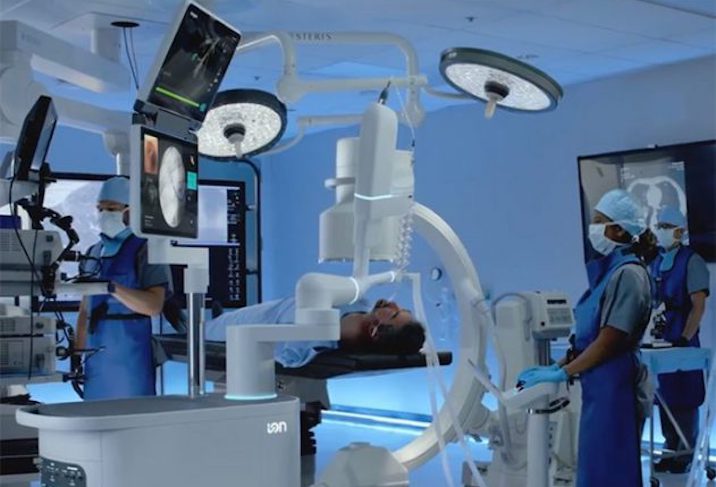ROBO Global index member Intuitive Surgical continues to drive the healthcare robotics revolution, and investors are taking note. Its shares have climbed 17% so far this year (as of March 25, 2019) and returned a total 184% in the past three years. That’s on the heels of a reported sales growth of 19% in 2018. But the current stock price isn’t what has been drawing the most attention to Intuitive Surgical in recent weeks. The main attraction has been innovation, pure and simple.
Intuitive Surgical made a name for itself with its da Vinci robotics surgery system, which was used to perform more than a million procedures in 2018. Providing a clear and highly magnified view inside the patient's body, this remarkable system of advanced instruments and 3D HD vision enables surgeons to perform surgeries using just a few small incisions rather than traditional methods of ‘open’ surgery. The company designs, manufactures, and markets the systems, as well as other da Vinci system-related instruments and surgical accessories such as surgeon's consoles, patient-side carts, 3-D vision systems, skills simulators, integrated table motions, and fluorescence imaging products. Da Vinci has transformed how surgeons perform a variety of surgical procedures, primarily urologic and gynecologic, but also increasingly general, cardiothoracic, and head and neck surgeries. The company launched 80 new products in its da Vinci ecosystem in the past three years alone, and as the technology continues to advance, the list of surgical applications da Vinci can support is likely to grow significantly.
As is true in all areas of healthcare, a global aging population is leading to a substantial increase in the number of surgical procedures performed, a growing part of which can be assisted by robotics and AI. Going forward, treating lung cancer—the world’s leading cause of cancer deaths—is at the top of the list. Intuitive Surgical’s new Ion™ surgical system is set to transform how surgeons treat this deadly disease. The company recently announced FDA clearance for Ion, which uses flexible robotic catheters that are enabled by AI and computer vision to obtain lung biopsies in a minimally invasive procedure. Ion makes it possible to navigate around tiny curves within the body, and its tiny, ultra-thin (2mm) catheter can even be used to gather biopsies using miniature forceps or to collect cell samples using a cytology brush. Gary Guthart, Intuitive Surgical’s CEO, has indicated that that product is expected to do particularly well in markets where cases of lung cancer and lung diseases are on the rise—including China.[1] The company plans to begin shipping the Ion system as early as 2Q19.
It’s no surprise that Intuitive Surgical’s success, both past and present, has created a stir among the competition. Just last month, Johnson & Johnson made headlines for its acquisition of Auris Health for $3.4B in cash. The purchase adds Monarch, Auris’s FDA-approved robotics system for diagnosing and treating lung cancer, to its robotics and AI initiative centered on Verb Surgical, a joint venture formed in 2015 with Verily (formerly Google Life Sciences). And J&J isn’t the only healthcare player seeking to boost its presence in the fast-growing field of robotic surgery. Last year, Medtronic completed the $1.6B acquisition of former ROBO Index member Mazor Robotics, the pioneer and leader in robotics solutions for spine surgery. In late 2013, Stryker acquired Mako, which specializes in orthopedic robotics surgery, for a similar amount. In 2016, Zimmer Biomet acquired French surgical robotics maker MedTech SA.
The increase in competition will no doubt bring more good news for patients, but it’s unlikely to dampen the trajectory of Intuitive Surgical. As the bona fide market gorilla, the company has already garnered the lion’s share of the current market, and its track record of delivering consistent quality has created a high level of customer loyalty. We view Intuitive Surgical’s competitive position as very strong. First, its track record of innovation is remarkable. As emerging competitors strive to prove their ability to deliver their own high-quality, high-value solutions, the company will likely barrel ahead with new innovations and, as a result, continue to build on its already impressive market dominance and strengthen its lead. Second, the company’s offering is increasingly integrated, with multiple interconnected systems (X, Xi, SP, and now Ion). Third, its training, education and support services are enabled by more than 2,000 da Vinci simulators, as well as fully developed training protocols. Lastly, Intuitive Surgical has a significant data advantage across a wide array of specialties.
We anticipate continued high-teens growth in 2019 and beyond. The company reported cash, cash equivalents, and investments of $4.8B at the end of 2018, giving it plenty of resources to boost its already impressive R&D expenditures and to make strategic acquisitions. The market for surgical robotics is already large. With TAM expected to expand dramatically for spinal, orthopedic, and bariatric surgeries, it appears that Intuitive Surgical has plenty of room to grow.
By Jeremie Capron, Director of Research, ROBO Global
[1] “Intuitive Surgical CEO: Helping surgeons avoid harming healthy tissue,” CNBC, March 5, 2019





